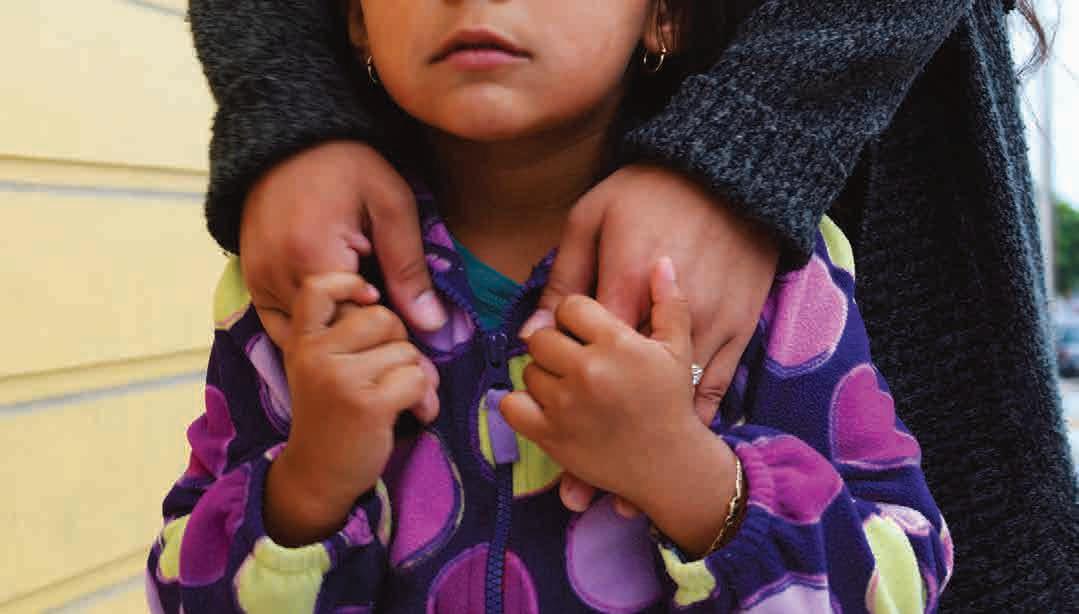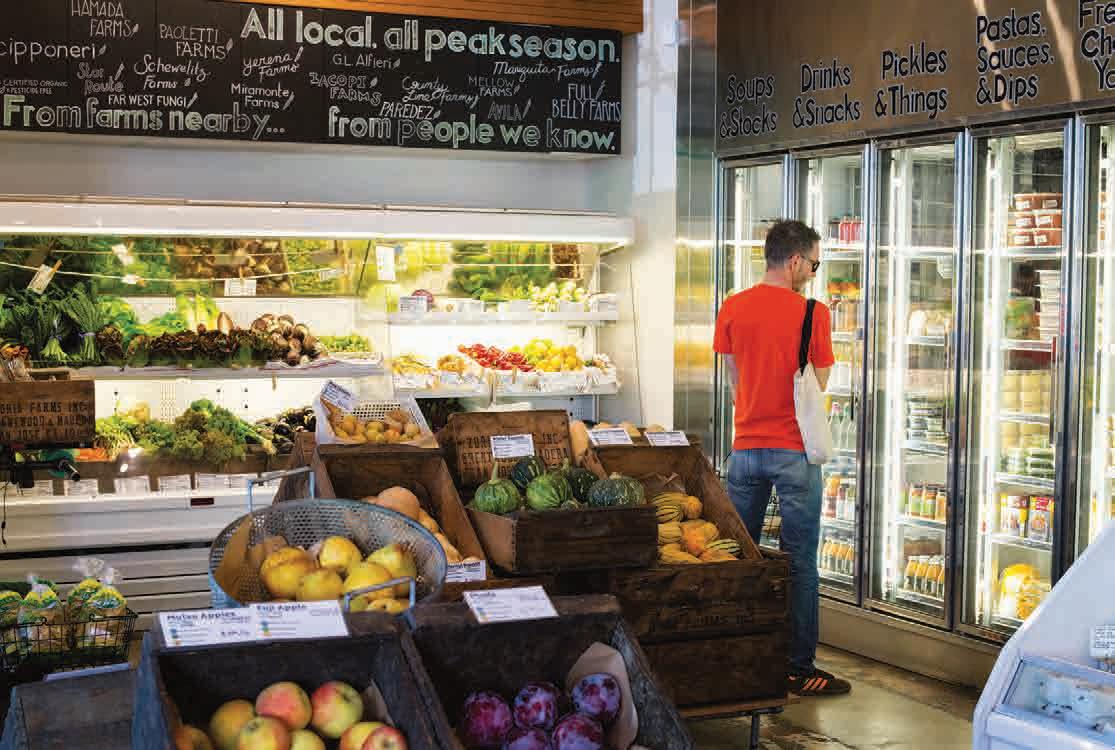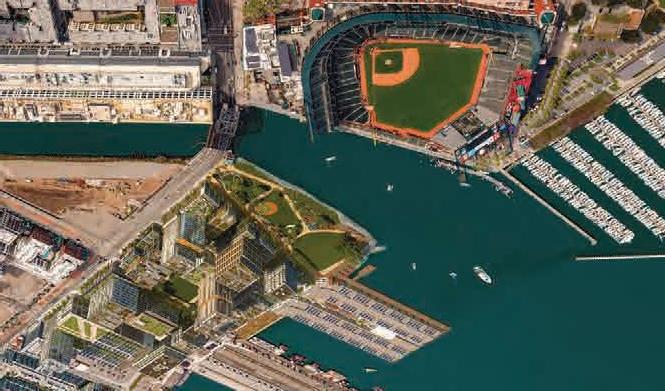
18 minute read
bright-green farmland in the Valley is desert. Some of the A great swath of the Central
San Francisco to Expand Health Insurance Support
Federal affordability scale falls far short of helping thousands pay for coverage
Advertisement
By Angela Woodall // Public Press
The cost of living in San Francisco is so distorted that several thousand city residents who became eligible for health insurance subsidies under the Affordable Care Act almost two years ago still go without insurance, forgo care they need, or use free services intended for the poor.
They make too much to qualify for Medi-Cal or the city’s Healthy San Francisco program but not enough to afford the premiums, deductibles and co-pays for plans under Covered California, the state’s new program adopted under the Affordable Care Act.
New federal data show that people nationwide are in this bind. But the scale the federal government uses to measure affordability is especially inapplicable to San Francisco, ranked the third-most-expensive place to live in the world.
To help offset that imbalance, San Francisco is offering a new, subsidized plan and expanding Healthy San Francisco to bridge the gap for city residents caught between the need for health insurance and their ability to afford it.
Covered California premiums are relatively affordable. The cheapest one for single San Franciscans earning $58,850 — the cutoff for the new city subsidy — would cost roughly $202 a month. But the cheapest plans have the highest deductibles, out-of-pocket expenses for doctor visits, hospital stays and drug prescriptions, potentially totaling thousands of dollars per year. And the subsidies for these expenses that are available in states with market exchanges, like California, come only with plans on the costlier “silver” tier. As a result, many residents choose to remain uninsured, said Colleen Chawla, deputy director of health at the San Francisco Public Health Department.
This means people eligible for Covered California are turning to clinics intended for people who can’t get in
surance at all or who have Medi-Cal, the state's version of free medical insurance for very low-income residents.
“We have as many patients as ever,” said Richard Gibbs, the president of the San Francisco Free Clinic. “We’re here to catch them, and they’re still falling through the cracks.”
San Francisco often takes the lead nationwide with social programs because of the city’s values, said Anthony Wright, executive director of Health Access, a consumer health care advocacy group in Sacramento that backed San Francisco's plans. And the adoption in 2007 of Healthy San Francisco, which provides free care inside the city for poor residents who don’t qualify for any subsidies, was supposed to ensure that all San Franciscans got the care they needed. So far, the Public Health Department has spent more than $885 million on Healthy San Francisco alone, and even more on other health care programs.
But the rising cost of living has stayed several steps ahead of San Francisco’s best efforts to fight it. Responding to this reality, San Francisco’s Department of Public Health is rolling out two programs in 2016 for working people who fit three criteria: they are eligible for the Covered California plan; they make less than five times the federal poverty level ($58,850 for a single person, for example, or $121,250 for a family of four); and they work for employers that pay into a citymandated health insurance account instead of offering insurance as an employee benefit.
One program, Bridge to Coverage, will help these lowand moderate-income residents pay their Covered California premiums using funds from the city’s employer health insurance account. The city expects 3,000 people to enroll the first year and 1,000 more by 2020, and it expects the program to cost $8 million the first year.
The second program would allow those same residents to choose free care under Healthy San Francisco by expanding the income ceiling. That could help people caught in the middle, such as workers who are self-employed. Although some self-employed people can write off health care costs when they file their taxes, they still have to pay the premiums, deductibles and co-pays out of pocket before receiving a tax credit months down the road. Importantly, users will still have to pay a fine under the Affordable Care Act for not having health insurance because Healthy San Francisco provides only care; it is not insurance. The Public Health Department does not expect many people to opt for either program, which the city is calling “affordability extensions.”
And it is not clear whether either break would be enough to shield people from the pressure that housing and other costs are putting on residents. At least one nonprofit clinic is asking how long it should — or can — keep operating in this climate. The rising cost of living has led many patients of the Native American Health Center to move out of San Francisco, said the center’s strategy director, D’Shane Barnett.
“The Affordable Care Act has done a lot for our clients,” he said. “The cost of living, on the other hand, is pushing them out of San Francisco. So it doesn’t matter how good it is.”
San Francisco’s high cost of living is even pushing out the clinic’s modestly paid staffers. Two have moved across the bay. One now commutes from Newark, near Fremont, and another moved to San Leandro. If free and low-cost clinics close, it could weaken the safety net that took San Francisco decades to build — and that the Affordable Care Act promised to strengthen.
“We have to make a decision about whether we stay here,” Barnett said. “But we need to make sure we’re making a decision in the community’s best interest not just 12 months from now but 10 years from now.”
State Subsidies Lag Behind Local Child-Care Costs
With eligibility for aid frozen at 2005 income levels, critics press for wider distribution of aid
By Tatiana Dzekon // Public Press

Julia and her 4-year-old daughter got their big break last year when Julia was hired full-time as a program coordinator for a local nonprofit organization at $50,000 a year.
They had been homeless for the child’s first seven months, and they struggled for two more years as Julia worked full time at minimum-wage jobs. But the only reason Julia is making the rent now on their apartment in a rundown building in the Bayview is that her daughter’s care is fully subsidized. Yet, if she reports her new income as required, that will disqualify her for the subsidy.
Like other low-and moderate-income San Francisco parents with young children and

no relatives nearby to provide free care, Julia, whose husband is incarcerated, faces a series of obstacles paying for child care so she can support her household. Half her pay would go toward her daughter’s tuition at market rates. But, to receive any subsidy at all, a family of three must earn less than $42,216, and a family of two, like Julia’s, must earn less than $39,393. (The Public Press is not using Julia’s full name in order not to jeopardize her benefits and livelihood.)
Part of the problem is that the income cutoff to qualify for subsidies is based on the 2005 state median income, while the average cost of putting a preschooler in care full time has almost doubled since then, rising from $9,786 to $18,000, according to city figures. The squeeze is especially tight in San Francisco because that increase is much greater than what state officials report for other Bay Area counties and California as a whole.
“It makes it nearly impossible for two parents making minimum wage in San Francisco to get subsidies, because they make too much,” said Monica Walters, director of Wu Yee Children’s Services, a local agency that serves about 3,500 children and families. “It’s foolhardy, because folks who want to get ahead and go to school and go to work are hit the hardest.”
In 1998, a state child-care voucher for low-income parents provided access to 85 percent of licensed centers in San Francisco, as it was designed to do. By 2012, It takes Julia two hours — and four buses — to drop her daughter off at day care and get to work. She said she worries that the salary she earns on her new job will disqualify her from state subsidies that enable her to remain in the workforce. Photo by Dayvon Dunaway // Public Press
not one child-care center in San Francisco charged tuition to match those vouchers, according to the San Francisco Human Services Agency and the Controller’s Office. Today, the subsidies cover 77 percent of the statewide average cost of preschool care and 87 percent of the average cost of infant care.
“Somebody should have sued and they would have won,” said Michele Rutherford, the deputy director of the San Francisco Office of Early Care and Education, “because the reimbursements don’t give families access to the market.”
Rutherford said this situation persists because the state’s process for measuring costs doesn’t reflect reality. Federal law requires the California Department of Education to study regional market rates every two years, but the state is not required to adjust its subsidy ceilings to comport with what it finds. Compounding the problem, the state now bases its subsidies on the results of the 2009 Regional Market Rate Survey — minus a 10.1 percent cut made in January to address a budget deficit that was partially offset by a 4.5 percent increase in June.
When asked why the subsidy cutoffs are set so low that families with two parents earning minimum wage don’t qualify, Margaret Reis, the state’s policy administrator for early childhood education, sidestepped the question. She said her agency surveys prices every two years as required, the Legislature proposes budgets that set the subsidy ceilings, and the governor implements them.
While those bureaucratic wheels turn, child-care prices continue soaring beyond the reach of even more middle-income San Francisco families.
Elizabeth Travelslight discovered it was cheaper for her to stay home with her baby than to work full time and pay for full-time care of an infant. Now that her daughter is 2 years old, Travelslight works part time as

an adjunct professor at the San Francisco Art Institute, and her mother watches her daughter once or twice a week to keep down costs.
“We’re a pretty middle-income family of three and make do in a one-bedroom apartment,” Travelslight said. “We’ll be with many families vying for space in the city’s few nursery co-ops.”
Orkid Sassouni said she has to make sacrifices all the time to be able to put her kids in quality care. She lives in Bernal Heights and works as a librarian’s assistant. As a city employee, she gets access to the day care at City Hall, but she also works on the weekends when the center is closed.
“The cost of living really hurts families who just feel like they need to give up living in the city because it is better suited for millionaires and couples with a dual income and no kids,” Sassouni said.
And Julia said she has no idea how she will cope with the cost of after-school care when her daughter outgrows her child-care subsidy as she starts kindergarten next year.
Solution for crossword on page A2
Hidden Costs of Affordable S.F. Public Transit
Low-income residents relying on upredictable service lose economic opportunity
By Sophie Murguia // Public Press
San Franciscans spend less on transportation than residents of any other Bay Area city. But there are hidden costs for public transit riders: unreliable trains, long, slow commutes and unsafe pedestrian routes.
Muni service is slow citywide, but it can be particularly burdensome for lower-income riders who must repeatedly switch lines or buses just to travel a few miles to downtown. Lacking transportation options or flexibility for when they must be at their jobs, they often trade comfort, promptness and even safety for affordability.
“If you think of affordability in terms of what you pay out of your pocket, you’re going to get wrong answers sometimes,” said Elizabeth Deakin, a professor of city and regional planning at the University of California, Berkeley. “What you want to think about is the overall time and cost combination that people can afford to pay with the incomes that they make.”
A single ride on Muni now costs $2.25, up from a dollar in 2000. And because more than half of Muni’s 702,000 weekday riders make less than 200 percent of the federal poverty level (or $23,540 for individuals, $31,836 for a family of two), rising fares have a disproportionate effect on low-income San Franciscans.
But the single-ride Muni fare remains on par with mass-transit fares in most major U.S. cities, and Muni offers reduced-fare programs to help ease the economic burden of transit for those who need it most.
“No other city has been as comprehensive as San Francisco has been in trying to make mobility more affordable,” said Joel Ramos, regional planning director at transportation advocacy group TransForm and a board member at the San Francisco Municipal Transportation Agency.
The Center for Neighborhood Technology, a nonprofit research group, estimates that a household making the city’s median income of nearly $76,000 spends $8,552 on transportation per year. In contrast, median-income households in other Bay Area counties often spend as much as $13,000 or $14,000 a year — largely because they rely more on automobiles.
But the San Francisco County Transportation Authority found in 2013 that low-income communities are disproportionately likely to experience slow transit and unsafe conditions for pedestrians.
THE COST OF A SLOW COMMUTE
For residents of lower-income neighborhoods like the Bayview, a slow commute is part of the price of getting around.
High school teacher D’Wana Stewart takes two buses from her Bayview home to her second job at Macy’s. “I take the 54 to the 8X, and that will be about 45 minutes to an hour,” she said.
She could take the T-Third Street light rail, but that takes even longer.
“It’s not as accessible,” she said. “And it doesn’t always come on time.”
Bayview resident Veronica Shepard commutes on the
By Peter Snarr // Public Press
In recent years, San Francisco has become the epicenter of technological development. While multibillion dollar companies develop the latest new Internet services, 100,000 San Francisco residents cannot afford a home connection, according to a report from the city’s budget and legislative analyst.
Access is increasingly taken for granted — for finding a job, attending all levels of school, managing a business, enjoying affordable entertainment and even communicating with family and friends.
So doing without puts people at an increased disadvantage.
Lourdes Alarcon, who supports herself and two children by providing child care out of her Excelsior home, cancels even her low-cost Internet access when her clients are home with their kids and not paying for her services.
While Alarcon pays $9.95 a month through Comcast, she has to cut her spending in any way possible to cover rent, clothing and food.
“It forces me to be on task when I use the Internet,” Alarcon said. “I have one hour at the library and I just go to do a list: interview, meeting with a teacher, check the email. I don’t like to use the Internet, but everyone is using it.”
The city report found that the 100,000 residents without home Internet access include: T–Third Street to work in Civic Center at the city Department of Public Health. She considers Muni “pretty cheap,” but her roughly 6-mile commute takes an hour door to door, and she says delays are constant.
“I’m paying for this service, but I’m not getting what the rest of San Francisco is getting,” she said.
In contrast, 94 percent of college graduates, 98 percent of homes with an income over $100,000, 90 percent of whites and 89 percent of Asian and Pacific Islanders do have access to home Internet.
Kami Griffiths, executive director and co-founder of the Community Technology Network, said some students stand outside coffeehouses to get the free Wi-Fi they need to do their schoolwork.
“Kids need Internet at home,” Griffiths said. “The academic divide is increased when they don’t. These kids are doing whatever they can to get their homework done.”
While the city report didn’t survey residents who access the Internet through mobile devices, Griffiths says the point is moot, asserting that mobile devices aren’t good tools for job searching and homework. She argues that one must have a home connection with a non-mobile device to fully utilize the Internet.
In public housing, where a disproportionate share of San Francisco’s young African-Americans live, Web access is a critical need, said Takai Tyler, executive
The T is one of Muni’s less reliable lines, but spotty service is a problem citywide. A recent city report found Muni’s on-time performance hovering at or below 60 percent, far below the 85 percent on-time performance rate mandated in San Francisco’s charter.
For 16-year-old Lisa Yu, it’s often faster to walk to director at Hunters Point Family after-school program.
“The majority do not have Internet access,” Tyler said. “The ability for someone to afford and buy a computer in public housing isn’t there. There’s also issues of the effectiveness of a good signal.”
The city and Internet providers have started to broaden access. Low-income seniors and families with at least one child in the National School Lunch Proone of the great equalizers.”
Jess Montejano, spokesman for Supervisor Mark Farrell
gram can get Comcast Internet access with download speeds of 10 megabits per second for $9.95 a month (including a router and installation). AT&T offers much slower service for about $36 a month at a 0.75 Mbps download rate. The FCC provides a $9.25 discount for low-income households, and offers the choice to spend Above: Public transit systems in San Francisco carry hundreds of thousands of passengers a day and make it possible to get around without buying and fueling a car.
Left: For those who live in the outer neighborhoods, such as Bayview, Muni and BART delays can come at a high cost: limited shopping and job opportunities.
Photos by Dayvon Dunaway // Public Press
school than to take the bus. She lives in Chinatown and attends high school 1.1 miles away at Galileo Academy. Because the city gives Muni passes to students in low- and moderate-income households, Yu can ride for free, but it can take as long as 25 minutes. Sometimes overcrowded buses will zoom by her stop without even loading new passengers. “That happens to me a lot,” she said.
WALKING IS CHEAP, BUT OFTEN DANGEROUS
A volunteer at the Chinatown Community Development Center, Rosa Chan advocates for pedestrian safety and affordable transit. She said Kearney Street, one of the neighborhood’s busiest streets, often feels like a highway because cars drive so fast along it. City research shows that a disproportionate number of San Francisco’s least safe streets are in communities with economically disadvantaged, minority and transit-reliant populations, such as Chinatown and the Tenderloin.
Peter Cohen, co-director of the Council of Community Housing Organizations, said the city has not done enough to address what he calls “the gentrification of
In the Heart of Tech, a Persistent Digital Divide
100,000 city residents cannot afford the Internet at home
• • 31 percent of residents over 65 32 percent of residents without a high school • diploma 25 percent of households with an income of • • less than $25,000 30 percent of African-Americans 16 percent of Latinos.
our transit system.” it on broadband or phone service. And there is limited free online access at San Francisco Public Library (an hour at 10 Mbps); inside most of the city’s 137 public schools; and outdoors in 33 city parks and near hot spots the city has set up along Market Street.
But that does not solve the needs of students with several hours of homework each night requiring Internet access. It is not enough for job-seeking residents who need to make dozens of applications online and be instantly available by email for employers that respond. And it can leave seniors and others without affordable entertainment or modern means of communication.
Those gaps increased in January when the Federal Communications Commission changed its definition of high-speed broadband to 25 Mbps for downloading and 4 Mbps for uploading. The agency’s 2015 Urban Rate Survey found that four Internet providers can deliver those speeds in San Francisco — at an average price of $68.75 a month for the most basic service.
Supervisor Mark Farrell in August called for the city’s budget and legislative analyst to research how San Francisco can deliver 1-gigabit-per-second Internet service to residents and businesses citywide for free or very low cost, according to a press release. Jess Montejano, a spokesman for Farrell, said the city might use public or private funding or both.




